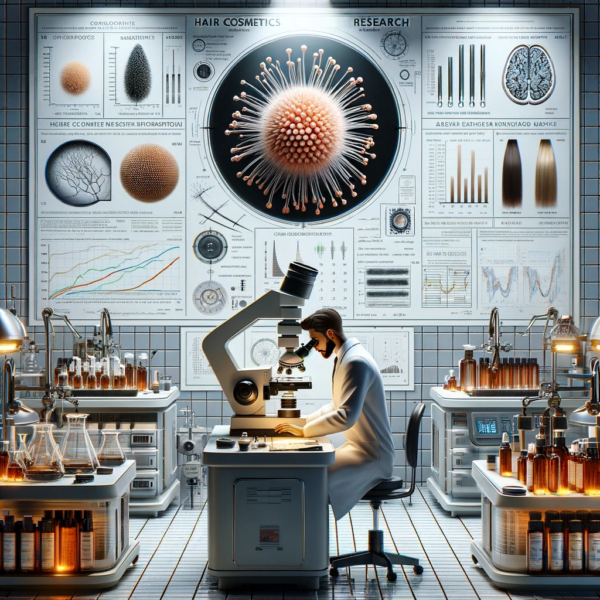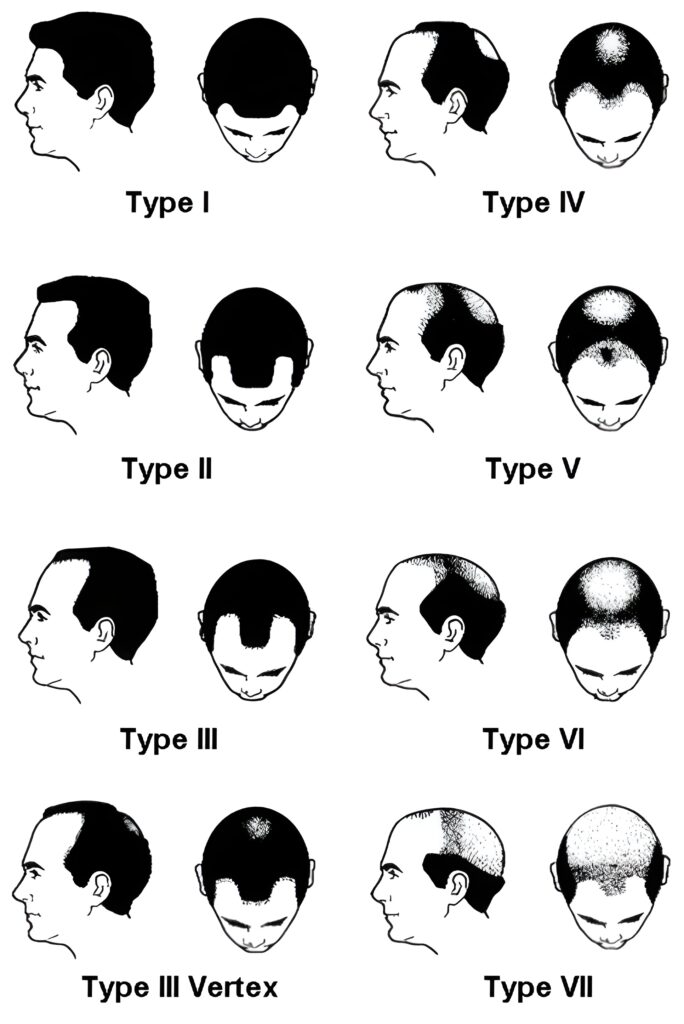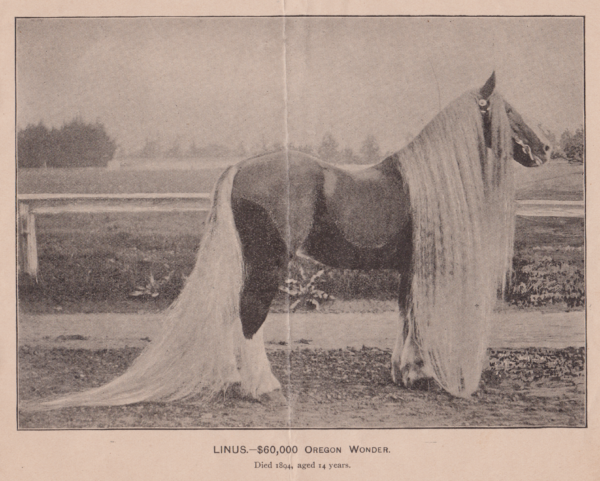Introduction : I get a few students contacting me looking for ideas on science projects about hair each year. This can be difficult because hair itself is rather uninteresting and does not do much. It doesn’t respond to stimuli, it’s hard keratinized material, and it’s dead. It’s like trying to think of something useful to do with nail clippings (which are made of the same material). As adults are obsessed with their hair, so kids inherit the interest sooner or later and some want to do science fair projects about it. Personally, I would much prefer to do some project involving creepy crawlies. I also have the added problem that I was not educated in the US education system. I grew up in England where you did what you were told in science classes and woe betide anyone who had their own idea for an experiment. So I am not familiar with science fair projects or what exactly they entail. However, below are a few ideas for projects involving hair based on studies that professional scientists have done at some time in hair biology history and some they may still do today for cosmetics companies.
Examining hair cosmetics : Many kids want to do a project on hair cosmetics. The problem with examining the effects of cosmetics on hair is that the changes are very subtle and difficult to quantify without using quite sophisticated machines. Cosmetics companies look at hair quality by subjecting hair fiber to the cosmetic of interest and then examining the results by electron microscopy or perhaps chemical analysis. Alternatively, there are some special machines that can be used to measure light reflectance and speckle pattern. These methods are expensive and not readily accessible to most school teachers, unless perhaps you have some connections in the hair cosmetics industry. Companies focus on what shampoo does to the cuticle. Does the cuticle flake and crack easily? Does the cuticle reflect light well and look shiny? These are subtle changes not easily observed with equipment typically found in a school lab. Effects on hair by different shampoos or shampoo versus “placebo” will probably not show quantifiable differences.
However, what students could do is mimic the semi quantifiable data collection methods that cosmetic companies use. They can get their friends to each try a different shampoo for a set length of time, ask the users for their impressions and evaluate hair quality from photos or visual examination using arbitrary scales for light reflectance, manageability, feel during application, quality impression by the user, and so on. This is not hard science, but it can be made into something that requires a lot of statistical analysis and it requires good interpersonal skills. These days it is quite common for cosmetics companies to use focus groups to evaluate their products in this way. You may even have seen TV adverts that have a line at the bottom of the screen saying “x% of users agree” with whatever claim the company is making.
Ideally such a project would involve many people using the same shampoo to reduce the impact of the users’ genetic hair quality. Differences in hair care habits need to be standardized (How frequent is washing? How long is the shampoo on the scalp? How old is the hair that it is being applied to [sections of hair at the end of long strands is several years old – the ends of short hair may be a few months old]). Other things to consider will be what other cosmetics do they use on their hair (conditioner)?, do they color/perm hair?, how often do they comb the hair? How much exposure is there to air pollution? and so on. Trying to standardize such a project will not be easy, but would certainly introduce students to the complexities of experimental design and the kind of problems cosmetics testers face.
To make things somewhat easier, rather than looking at cosmetics that are similar (shampoos, conditioners) you might consider looking at very different formulations such as brilliantines and pomades versus hair gel and oil – water emulsions. Or perhaps look at all-in-one shampoos and conditioners versus using separate shampoo and conditioner from the same company. Which does the focus group find superior and why?
Measuring hair fiber strength under different conditions : Hair takes on different properties depending on humidity, chemicals, and other treatments it has been exposed to. You might try looking at the strength of hair that has been treated in different ways. The basic system involves tying a strand or maybe several strands of hair to a stand. At the other end tie a hook that you can hang weights on. Put a ruler by the side of the hair fiber and add the weight gradually. As you gradually add the weight, you should see the hair fiber stretch before it breaks. By measuring the length of hair at different weights and plotting the results on a graph you should get a nice curve. By recording the amount of weight it takes to break the hair you can work out the hair strength.
To make things more interesting, take a few hair strands from someone who does not chemically treat their hair and some strands from someone who perms, bleaches, or permanently colors their hair. Ideally get and use the treated hair within 24 hours of treatment (try the local hair salon for volunteers). Compare the “stretchability” of treated and untreated hair and the overall strength. Treated hair should be weaker although if there is enough time between treatment and testing the hair will recover most its strength (though it never quite gets back to full strength).
Alternatively, look at the properties of wet and dry hair. Hair immersed in water for an hour will swell by up to 20%. Ideally, heat the water to 50 degrees centigrade to get maximum absorption into the hair. Test the strength of this wet hair versus “dry” hair (not strictly dry as all hair takes in water to some degree depending on air humidity). The wet hair should be weaker by up to 30%. Hair strength in normal air humidity is somewhere between 1,000,000gm/cm square to 1,250,000gm/cm square – as strong as copper wire of similar diameter. Other options could include looking at hair that has been exposed to different pH solutions for a fixed period of time. Or alternatively, compare wet hair that has been exposed to a high heat hair dryer versus cool air.
Hair loss measurement : Why not get kids to record the degrees of male pattern hair loss in people? Use the standard Norwood scale on this page. Open the image in a new window to get a bigger picture to download and print. Give the kids a copy of the picture each and have them observe passers-by; best from an elevated position. Have them look at perhaps 100 men and to record the person’s extent of hair loss and their estimated age. Or perhaps you find a live camera feed of a public place somewhere with lots of people to use in class. The children should be able to plot the extent of hair loss against age and see a line. The kids should also be able to see that the percentage of men with baldness increases with age. About 20% of men in their 20s have pattern baldness, 30% of men in their 30s and so on until about 60 years of age where the trend is lost. If men have not lost any hair by age 60 they are very unlikely to do so. These kinds of epidemiology studies are still being published looking at different populations of people across the world and how androgenetic alopecia is similar/different.
Hair growth rates : Get an adult who normally shaves every day to let his (her?) beard grow over the weekend or longer if possible. Ask them to shave off the beard growth after a couple of days and collect the stubble. If they wet shave, they can collect the stubble by shaving using a bowel of water and then pouring the soap, water, and stubble into a coffee filter paper. Pour a few cups of water through the paper to wash away the soap and let the hair dry out. Then you need to mount the hairs on several slides. You can do this properly by spreading the hairs on slides using tweezers and applying some mounting medium and a cover slip, or you can do it more quickly by using see through sticky tape to tape over the slide and hold the hair fibers in place.
Here comes the exciting bit! The kids get to measure the individual cut hairs and plot them on a chart! Use a microscope with an eyepiece graticule to measure the lengths of individual fibers. You do not have to measure all the individual hairs – you can use random sampling. Random sampling means you measure say 50 hairs at random from the slides.
You can estimate the rate of hair growth by adding up all the hair lengths you measure and dividing by the number of hairs measured. This should give you the average length of the hairs. If you know how long the beard has been growing (2 days, 3 days etc.) then you can work out the average rate of growth for beard hair. More advanced students can work out the standard deviation and standard error for the data. Beard growth rate varies from person to person and depends on their health and age. The rate can be anything up to 0.4mm a day.
There are a couple of different ways you can plot the measurements out on a chart. You could group the measurements into sets. For example, you can make up size classes, 0-49 micrometers, 50-99 micrometers, 100-149 micrometers and so on. Count the number of fibers that are 0-49 micrometers in length and so on. You can the plot these sets on a bar chart to show the range of hair sizes. You can also do dispersion diagrams, plotting the different lengths of hair along a line on graph paper. You could add marks to show the upper quartile, median and lower quartile ranges. You can probably think of other ways to plot the data too.
These kinds of hair growth measurement studies were first done in the 1920s by Dr Mildred Trotter and involved regular hair shaving by volunteers on all parts of the body. Through time the studies have been repeated and expanded such that we have a good idea of hair growth rates for different parts of the body and differences due to age or sex. Typical hair growth rates are discussed on other pages on this website.
Bibliography
11711645 {11711645:FTSDDPME},{11711645:TNPQ5REP},{11711645:SRMVRS35},{11711645:GIK3S6B3},{11711645:R8NAU5V9},{11711645:3DF5AHB8},{11711645:HG8A535N},{11711645:BC55D757},{11711645:8E2CD9TG},{11711645:WBKDV7XM},{11711645:5P3WN774},{11711645:TUFATBFX},{11711645:R6F6QXQD},{11711645:RK6P55ZT},{11711645:M9CSWBPT} 1 vancouver 50 date asc 582 https://www.keratin.com/wp-content/plugins/zotpress/ %7B%22status%22%3A%22success%22%2C%22updateneeded%22%3Afalse%2C%22instance%22%3Afalse%2C%22meta%22%3A%7B%22request_last%22%3A0%2C%22request_next%22%3A0%2C%22used_cache%22%3Atrue%7D%2C%22data%22%3A%5B%7B%22key%22%3A%22FTSDDPME%22%2C%22library%22%3A%7B%22id%22%3A11711645%7D%2C%22meta%22%3A%7B%22creatorSummary%22%3A%22Trotter%22%2C%22parsedDate%22%3A%221928%22%2C%22numChildren%22%3A0%7D%2C%22bib%22%3A%22%3Cdiv%20class%3D%5C%22csl-bib-body%5C%22%20style%3D%5C%22line-height%3A%201.35%3B%20%5C%22%3E%5Cn%20%20%3Cdiv%20class%3D%5C%22csl-entry%5C%22%20style%3D%5C%22clear%3A%20left%3B%20%5C%22%3E%5Cn%20%20%20%20%3Cdiv%20class%3D%5C%22csl-left-margin%5C%22%20style%3D%5C%22float%3A%20left%3B%20padding-right%3A%200.5em%3B%20text-align%3A%20right%3B%20width%3A%201em%3B%5C%22%3E1.%3C%5C%2Fdiv%3E%3Cdiv%20class%3D%5C%22csl-right-inline%5C%22%20style%3D%5C%22margin%3A%200%20.4em%200%201.5em%3B%5C%22%3ETrotter%20M.%20Hair%20growth%20and%20shaving.%20Anat%20Rec.%201928%3B37%284%29%3A373%26%23x2013%3B9.%3C%5C%2Fdiv%3E%5Cn%20%20%20%3C%5C%2Fdiv%3E%5Cn%3C%5C%2Fdiv%3E%22%2C%22data%22%3A%7B%22itemType%22%3A%22journalArticle%22%2C%22title%22%3A%22Hair%20growth%20and%20shaving%22%2C%22creators%22%3A%5B%7B%22creatorType%22%3A%22author%22%2C%22firstName%22%3A%22Mildred%22%2C%22lastName%22%3A%22Trotter%22%7D%5D%2C%22abstractNote%22%3A%22%22%2C%22date%22%3A%2202%5C%2F1928%22%2C%22language%22%3A%22en%22%2C%22DOI%22%3A%2210.1002%5C%2Far.1090370405%22%2C%22ISSN%22%3A%220003-276X%2C%201097-0185%22%2C%22url%22%3A%22%22%2C%22collections%22%3A%5B%22HB5VQ4R3%22%5D%2C%22dateModified%22%3A%222023-07-26T15%3A55%3A47Z%22%7D%7D%2C%7B%22key%22%3A%22TNPQ5REP%22%2C%22library%22%3A%7B%22id%22%3A11711645%7D%2C%22meta%22%3A%7B%22creatorSummary%22%3A%22Norwood%22%2C%22parsedDate%22%3A%221975-11%22%2C%22numChildren%22%3A0%7D%2C%22bib%22%3A%22%3Cdiv%20class%3D%5C%22csl-bib-body%5C%22%20style%3D%5C%22line-height%3A%201.35%3B%20%5C%22%3E%5Cn%20%20%3Cdiv%20class%3D%5C%22csl-entry%5C%22%20style%3D%5C%22clear%3A%20left%3B%20%5C%22%3E%5Cn%20%20%20%20%3Cdiv%20class%3D%5C%22csl-left-margin%5C%22%20style%3D%5C%22float%3A%20left%3B%20padding-right%3A%200.5em%3B%20text-align%3A%20right%3B%20width%3A%201em%3B%5C%22%3E1.%3C%5C%2Fdiv%3E%3Cdiv%20class%3D%5C%22csl-right-inline%5C%22%20style%3D%5C%22margin%3A%200%20.4em%200%201.5em%3B%5C%22%3ENorwood%20OT.%20Male%20pattern%20baldness%3A%20classification%20and%20incidence.%20South%20Med%20J.%201975%20Nov%3B68%2811%29%3A1359%26%23x2013%3B65.%3C%5C%2Fdiv%3E%5Cn%20%20%20%3C%5C%2Fdiv%3E%5Cn%3C%5C%2Fdiv%3E%22%2C%22data%22%3A%7B%22itemType%22%3A%22journalArticle%22%2C%22title%22%3A%22Male%20pattern%20baldness%3A%20classification%20and%20incidence%22%2C%22creators%22%3A%5B%7B%22creatorType%22%3A%22author%22%2C%22firstName%22%3A%22O.%20T.%22%2C%22lastName%22%3A%22Norwood%22%7D%5D%2C%22abstractNote%22%3A%22The%20need%20for%20a%20widely%20accepted%2C%20accurate%2C%20and%20reproducible%20standard%20of%20classification%20for%20male%20pattern%20baldness%20has%20increased%20with%20the%20advent%20and%20increasing%20popularity%20of%20hair%20transplant%20surgery.%20This%20report%20establishes%20such%20a%20classification%2C%20and%20reports%20its%20use%20in%20determining%20the%20incidence%20of%20male%20pattern%20baldness%20at%20various%20ages%20in%201%2C000%20white%20adult%20male%20subjects.%20The%20action%20of%20testosterone%20as%20an%20incitant%20in%20male%20pattern%20baldness%20is%20well%20known%2C%20but%20this%20study%20points%20out%20the%20continued%20effect%20of%20time%2C%20even%20in%20later%20years.%20Since%20most%20hair%20transplant%20surgery%20is%20peformed%20on%20subjects%20with%20male%20pattern%20baldness%2C%20and%20because%20the%20success%20of%20hair%20transplant%20surgery%20is%20largely%20dependent%20on%20proper%20patient%20selection%2C%20a%20complete%20understanding%20of%20male%20pattern%20baldness%20is%20essential%20for%20consistently%20good%20results%20with%20hair%20transplantation.%22%2C%22date%22%3A%221975-11%22%2C%22language%22%3A%22eng%22%2C%22DOI%22%3A%2210.1097%5C%2F00007611-197511000-00009%22%2C%22ISSN%22%3A%220038-4348%22%2C%22url%22%3A%22%22%2C%22collections%22%3A%5B%22XBNK6T7F%22%5D%2C%22dateModified%22%3A%222023-10-31T14%3A39%3A58Z%22%7D%7D%2C%7B%22key%22%3A%22GIK3S6B3%22%2C%22library%22%3A%7B%22id%22%3A11711645%7D%2C%22meta%22%3A%7B%22creatorSummary%22%3A%22Dawber%22%2C%22parsedDate%22%3A%222002-12%22%2C%22numChildren%22%3A0%7D%2C%22bib%22%3A%22%3Cdiv%20class%3D%5C%22csl-bib-body%5C%22%20style%3D%5C%22line-height%3A%201.35%3B%20%5C%22%3E%5Cn%20%20%3Cdiv%20class%3D%5C%22csl-entry%5C%22%20style%3D%5C%22clear%3A%20left%3B%20%5C%22%3E%5Cn%20%20%20%20%3Cdiv%20class%3D%5C%22csl-left-margin%5C%22%20style%3D%5C%22float%3A%20left%3B%20padding-right%3A%200.5em%3B%20text-align%3A%20right%3B%20width%3A%201em%3B%5C%22%3E1.%3C%5C%2Fdiv%3E%3Cdiv%20class%3D%5C%22csl-right-inline%5C%22%20style%3D%5C%22margin%3A%200%20.4em%200%201.5em%3B%5C%22%3EDawber%20R.%20Cosmetic%20and%20medical%20causes%20of%20hair%20weathering.%20J%20Cosmet%20Dermatol.%202002%20Dec%3B1%284%29%3A196%26%23x2013%3B201.%3C%5C%2Fdiv%3E%5Cn%20%20%20%3C%5C%2Fdiv%3E%5Cn%3C%5C%2Fdiv%3E%22%2C%22data%22%3A%7B%22itemType%22%3A%22journalArticle%22%2C%22title%22%3A%22Cosmetic%20and%20medical%20causes%20of%20hair%20weathering%22%2C%22creators%22%3A%5B%7B%22creatorType%22%3A%22author%22%2C%22firstName%22%3A%22Rodney%22%2C%22lastName%22%3A%22Dawber%22%7D%5D%2C%22abstractNote%22%3A%22To%20experts%20in%20any%20aesthetic%20field%2C%20scalp%20hair%20has%20%27life%27.%20But%20in%20any%20scientific%20sense%20it%20is%20a%20dead%20structure%20made%20up%20of%20highly%20organized%20and%20orientated%20keratinized%20fibres%20and%20fibrils%3B%20and%20these%20can%20be%20modified%20by%20cosmetic%20procedures%20to%20give%20a%20seemingly%20infinite%20variety%20of%20beautiful%20and%20exciting%20styles.%20As%20the%20hair%20grows%20away%20from%20the%20scalp%20it%20degenerates%20or%20%27weathers%27%20to%20some%20degree%20and%20this%20can%20be%20exaggerated%20by%20physical%20and%20chemical%20procedures%20such%20as%20overzealous%20brushing%2C%20bleaching%2C%20permanent%20waving%20and%20tricotillomania.%22%2C%22date%22%3A%222002-12%22%2C%22language%22%3A%22eng%22%2C%22DOI%22%3A%2210.1111%5C%2Fj.1473-2165.2002.00049.x%22%2C%22ISSN%22%3A%221473-2165%22%2C%22url%22%3A%22%22%2C%22collections%22%3A%5B%22DEXR4KMK%22%5D%2C%22dateModified%22%3A%222023-07-23T19%3A52%3A44Z%22%7D%7D%2C%7B%22key%22%3A%22RK6P55ZT%22%2C%22library%22%3A%7B%22id%22%3A11711645%7D%2C%22meta%22%3A%7B%22creatorSummary%22%3A%22Okamoto%20et%20al.%22%2C%22parsedDate%22%3A%222003%22%2C%22numChildren%22%3A0%7D%2C%22bib%22%3A%22%3Cdiv%20class%3D%5C%22csl-bib-body%5C%22%20style%3D%5C%22line-height%3A%201.35%3B%20%5C%22%3E%5Cn%20%20%3Cdiv%20class%3D%5C%22csl-entry%5C%22%20style%3D%5C%22clear%3A%20left%3B%20%5C%22%3E%5Cn%20%20%20%20%3Cdiv%20class%3D%5C%22csl-left-margin%5C%22%20style%3D%5C%22float%3A%20left%3B%20padding-right%3A%200.5em%3B%20text-align%3A%20right%3B%20width%3A%201em%3B%5C%22%3E1.%3C%5C%2Fdiv%3E%3Cdiv%20class%3D%5C%22csl-right-inline%5C%22%20style%3D%5C%22margin%3A%200%20.4em%200%201.5em%3B%5C%22%3EOkamoto%20M%2C%20Yakawa%20R%2C%20Mamada%20A%2C%20Inoue%20S%2C%20Nagase%20S%2C%20Shibuichi%20S%2C%20et%20al.%20Influence%20of%20internal%20structures%20of%20hair%20fiber%20on%20hair%20appearance.%20III.%20Generation%20of%20light-scattering%20factors%20in%20hair%20cuticles%20and%20the%20influence%20on%20hair%20shine.%20J%20Cosmet%20Sci.%202003%3B54%284%29%3A353%26%23x2013%3B66.%3C%5C%2Fdiv%3E%5Cn%20%20%20%3C%5C%2Fdiv%3E%5Cn%3C%5C%2Fdiv%3E%22%2C%22data%22%3A%7B%22itemType%22%3A%22journalArticle%22%2C%22title%22%3A%22Influence%20of%20internal%20structures%20of%20hair%20fiber%20on%20hair%20appearance.%20III.%20Generation%20of%20light-scattering%20factors%20in%20hair%20cuticles%20and%20the%20influence%20on%20hair%20shine%22%2C%22creators%22%3A%5B%7B%22creatorType%22%3A%22author%22%2C%22firstName%22%3A%22Masayuki%22%2C%22lastName%22%3A%22Okamoto%22%7D%2C%7B%22creatorType%22%3A%22author%22%2C%22firstName%22%3A%22Ryoko%22%2C%22lastName%22%3A%22Yakawa%22%7D%2C%7B%22creatorType%22%3A%22author%22%2C%22firstName%22%3A%22Akira%22%2C%22lastName%22%3A%22Mamada%22%7D%2C%7B%22creatorType%22%3A%22author%22%2C%22firstName%22%3A%22Shigeto%22%2C%22lastName%22%3A%22Inoue%22%7D%2C%7B%22creatorType%22%3A%22author%22%2C%22firstName%22%3A%22Shinobu%22%2C%22lastName%22%3A%22Nagase%22%7D%2C%7B%22creatorType%22%3A%22author%22%2C%22firstName%22%3A%22Satoshi%22%2C%22lastName%22%3A%22Shibuichi%22%7D%2C%7B%22creatorType%22%3A%22author%22%2C%22firstName%22%3A%22Emiko%22%2C%22lastName%22%3A%22Kariya%22%7D%2C%7B%22creatorType%22%3A%22author%22%2C%22firstName%22%3A%22Naoki%22%2C%22lastName%22%3A%22Satoh%22%7D%5D%2C%22abstractNote%22%3A%22The%20effects%20of%20thermal%20treatments%20on%20hair%20fiber%20induced%20by%20blow-drying%20have%20been%20investigated.%20It%20was%20found%20that%20the%20hair%20shows%20whitish%20and%20powdery%20appearance%20after%20heat%20drying%2C%20especially%20when%20dark%20hair%20is%20rapidly%20dried%20from%20a%20wet%20condition.%20For%20all%20kinds%20of%20hair%2C%20the%20appearance%20of%20numerous%20glittering%20speckles%20was%20confirmed%20on%20the%20cuticle%20surface%20by%20optical%20microscopic%20observations.%20SEM%20images%20of%20hair%20transverse%20and%20longitudinal%20sections%20with%20glittering%20speckles%20revealed%20that%20the%20splitting%20of%20cuticle%20layers%20generated%20by%20blow-drying%20occurred%20not%20only%20at%20the%20outermost%20parts%20of%20cuticle%20cells%20but%20also%20at%20the%20inner%20parts%20of%20the%20cellular%20interfaces.%20The%20release%20and%20uptake%20of%20moisture%20through%20fiber%20surfaces%20induces%20deformation%20of%20cuticle%20cells%2C%20probably%20because%20of%20anisotropic%20swelling%20or%20drying%20of%20the%20cells.%20The%20cuticles%20with%20glittering%20speckles%20are%20found%20to%20be%20fragile%20and%20are%20easily%20damaged%20in%20combination%20with%20other%20mechanical%20stresses%20such%20as%20combing%20force.%20Furthermore%2C%20the%20authors%20have%20found%20an%20efficient%20system%20for%20both%20improving%20hair%20shine%20and%20preventing%20cuticle%20damage%20caused%20by%20the%20blow-drying%5C%2Fcombing%20process.%22%2C%22date%22%3A%222003%22%2C%22language%22%3A%22eng%22%2C%22DOI%22%3A%22%22%2C%22ISSN%22%3A%221525-7886%22%2C%22url%22%3A%22%22%2C%22collections%22%3A%5B%226DBN7BJW%22%5D%2C%22dateModified%22%3A%222023-10-31T16%3A11%3A44Z%22%7D%7D%2C%7B%22key%22%3A%22M9CSWBPT%22%2C%22library%22%3A%7B%22id%22%3A11711645%7D%2C%22meta%22%3A%7B%22creatorSummary%22%3A%22Persaud%20and%20Kamath%22%2C%22parsedDate%22%3A%222004%22%2C%22numChildren%22%3A0%7D%2C%22bib%22%3A%22%3Cdiv%20class%3D%5C%22csl-bib-body%5C%22%20style%3D%5C%22line-height%3A%201.35%3B%20%5C%22%3E%5Cn%20%20%3Cdiv%20class%3D%5C%22csl-entry%5C%22%20style%3D%5C%22clear%3A%20left%3B%20%5C%22%3E%5Cn%20%20%20%20%3Cdiv%20class%3D%5C%22csl-left-margin%5C%22%20style%3D%5C%22float%3A%20left%3B%20padding-right%3A%200.5em%3B%20text-align%3A%20right%3B%20width%3A%201em%3B%5C%22%3E1.%3C%5C%2Fdiv%3E%3Cdiv%20class%3D%5C%22csl-right-inline%5C%22%20style%3D%5C%22margin%3A%200%20.4em%200%201.5em%3B%5C%22%3EPersaud%20D%2C%20Kamath%20YK.%20Torsional%20method%20for%20evaluating%20hair%20damage%20and%20performance%20of%20hair%20care%20ingredients.%20J%20Cosmet%20Sci.%202004%3B55%20Suppl%3AS65-77.%3C%5C%2Fdiv%3E%5Cn%20%20%20%3C%5C%2Fdiv%3E%5Cn%3C%5C%2Fdiv%3E%22%2C%22data%22%3A%7B%22itemType%22%3A%22journalArticle%22%2C%22title%22%3A%22Torsional%20method%20for%20evaluating%20hair%20damage%20and%20performance%20of%20hair%20care%20ingredients%22%2C%22creators%22%3A%5B%7B%22creatorType%22%3A%22author%22%2C%22firstName%22%3A%22D.%22%2C%22lastName%22%3A%22Persaud%22%7D%2C%7B%22creatorType%22%3A%22author%22%2C%22firstName%22%3A%22Y.%20K.%22%2C%22lastName%22%3A%22Kamath%22%7D%5D%2C%22abstractNote%22%3A%22In%20this%20study%2C%20we%20have%20developed%20a%20single%20hair%20fiber%20torsional%20pendulum%20method%20to%20determine%20the%20role%20of%20the%20cuticle%20and%20the%20cortex%20on%20torsional%20properties%20with%20respect%20to%20fiber%20cross-sectional%20area%2C%20fiber%20rigidity%2C%20and%20energy%20dissipation%20at%2065%25%20RH%20and%20in%20the%20wet%20state.%20Our%20results%20demonstrate%20that%20in%20fine%20diameter%20fibers%20with%20a%20high%20cuticle-to-cortex%20ratio%2C%20the%20cuticula%20exert%20a%20significant%20effect%20on%20the%20torsional%20deformation%20behavior%20of%20hair%20fibers%20at%20both%20normal%20humidities%20and%20in%20the%20wet%20condition.%20In%20addition%2C%20our%20data%20indicate%20that%20energy%20dissipation%20is%20confined%20to%20fibers%20with%20a%20high%20cuticle-to-cortex%20ratio%2C%20and%20the%20amount%20of%20energy%20dissipated%20becomes%20more%20pronounced%20with%20increasing%20water%20content.%20The%20torsional%20properties%20of%20hair%20spray-treated%20fibers%20suggest%20that%20the%20deposited%20hair%20spray%20film%20masks%20the%20properties%20of%20the%20base%20fiber%20and%20imparts%20its%20own%20dissipative%20character%20to%20the%20measurement.%20Since%20tensile%20mechanical%20properties%20are%20often%20used%20to%20make%20claims%20about%20the%20performance%20of%20hair%20care%20products%2C%20we%20have%20compared%20the%20results%20obtained%20from%20torsional%20and%20tensile%20measurements%20on%20over-processed%20bleached%20hair%20fibers%20conditioned%20with%20Polyquaternium-10%20and%20cetyl%20trimethylammonium%20bromide%20%28CETAB%29%20to%20evaluate%20which%20method%20is%20more%20advantageous.%20Our%20data%20demonstrate%20that%20torsional%20measurements%20can%20distinguish%20hair%20care%20products%20which%20reinforce%20the%20cuticle%20from%20those%20which%20affect%20the%20cortex%2C%20while%20tensile%20measurements%20showed%20no%20significant%20differences.%22%2C%22date%22%3A%222004%22%2C%22language%22%3A%22eng%22%2C%22DOI%22%3A%22%22%2C%22ISSN%22%3A%221525-7886%22%2C%22url%22%3A%22%22%2C%22collections%22%3A%5B%226DBN7BJW%22%5D%2C%22dateModified%22%3A%222023-10-31T16%3A13%3A40Z%22%7D%7D%2C%7B%22key%22%3A%22HG8A535N%22%2C%22library%22%3A%7B%22id%22%3A11711645%7D%2C%22meta%22%3A%7B%22creatorSummary%22%3A%22Gamez-Garcia%20and%20Lu%22%2C%22parsedDate%22%3A%222007%22%2C%22numChildren%22%3A0%7D%2C%22bib%22%3A%22%3Cdiv%20class%3D%5C%22csl-bib-body%5C%22%20style%3D%5C%22line-height%3A%201.35%3B%20%5C%22%3E%5Cn%20%20%3Cdiv%20class%3D%5C%22csl-entry%5C%22%20style%3D%5C%22clear%3A%20left%3B%20%5C%22%3E%5Cn%20%20%20%20%3Cdiv%20class%3D%5C%22csl-left-margin%5C%22%20style%3D%5C%22float%3A%20left%3B%20padding-right%3A%200.5em%3B%20text-align%3A%20right%3B%20width%3A%201em%3B%5C%22%3E1.%3C%5C%2Fdiv%3E%3Cdiv%20class%3D%5C%22csl-right-inline%5C%22%20style%3D%5C%22margin%3A%200%20.4em%200%201.5em%3B%5C%22%3EGamez-Garcia%20M%2C%20Lu%20Y.%20Patterns%20of%20light%20interference%20produced%20by%20damaged%20cuticle%20cells%20in%20human%20hair.%20J%20Cosmet%20Sci.%202007%3B58%284%29%3A269%26%23x2013%3B82.%3C%5C%2Fdiv%3E%5Cn%20%20%20%3C%5C%2Fdiv%3E%5Cn%3C%5C%2Fdiv%3E%22%2C%22data%22%3A%7B%22itemType%22%3A%22journalArticle%22%2C%22title%22%3A%22Patterns%20of%20light%20interference%20produced%20by%20damaged%20cuticle%20cells%20in%20human%20hair%22%2C%22creators%22%3A%5B%7B%22creatorType%22%3A%22author%22%2C%22firstName%22%3A%22Manuel%22%2C%22lastName%22%3A%22Gamez-Garcia%22%7D%2C%7B%22creatorType%22%3A%22author%22%2C%22firstName%22%3A%22Yuan%22%2C%22lastName%22%3A%22Lu%22%7D%5D%2C%22abstractNote%22%3A%22Colorful%20patterns%20of%20light%20interference%20have%20been%20observed%20to%20occur%20in%20human%20hair%20cuticle%20cells.%20The%20light%20interference%20phenomenon%20has%20been%20analyzed%20by%20optical%20microscopy.%20The%20strong%20patterns%20of%20light%20interference%20appeared%20only%20in%20cuticle%20cells%20that%20had%20been%20damaged%20either%20mechanically%20or%20by%20thermal%20stresses.%20Cuticle%20cells%20that%20were%20not%20damaged%20did%20not%20produce%20this%20phenomenon.%20The%20zones%20of%20light%20interference%20on%20the%20hair%20surface%20were%20seen%20to%20extend%20to%20cuticle%20sheath%20areas%20whose%20damage%20was%20not%20apparent%20when%20analyzed%20under%20the%20Scanning%20Electron%20Microscope.%20The%20presence%20of%20oils%20and%20other%20hydrophobic%20materials%20in%20the%20hair%20had%20a%20strong%20effect%20in%20the%20appearance%20or%20disappearance%20of%20the%20interference%20patterns.%22%2C%22date%22%3A%222007%22%2C%22language%22%3A%22eng%22%2C%22DOI%22%3A%22%22%2C%22ISSN%22%3A%221525-7886%22%2C%22url%22%3A%22%22%2C%22collections%22%3A%5B%226DBN7BJW%22%5D%2C%22dateModified%22%3A%222023-10-31T16%3A11%3A08Z%22%7D%7D%2C%7B%22key%22%3A%225P3WN774%22%2C%22library%22%3A%7B%22id%22%3A11711645%7D%2C%22meta%22%3A%7B%22creatorSummary%22%3A%22Harper%20and%20Kamath%22%2C%22parsedDate%22%3A%222007%22%2C%22numChildren%22%3A0%7D%2C%22bib%22%3A%22%3Cdiv%20class%3D%5C%22csl-bib-body%5C%22%20style%3D%5C%22line-height%3A%201.35%3B%20%5C%22%3E%5Cn%20%20%3Cdiv%20class%3D%5C%22csl-entry%5C%22%20style%3D%5C%22clear%3A%20left%3B%20%5C%22%3E%5Cn%20%20%20%20%3Cdiv%20class%3D%5C%22csl-left-margin%5C%22%20style%3D%5C%22float%3A%20left%3B%20padding-right%3A%200.5em%3B%20text-align%3A%20right%3B%20width%3A%201em%3B%5C%22%3E1.%3C%5C%2Fdiv%3E%3Cdiv%20class%3D%5C%22csl-right-inline%5C%22%20style%3D%5C%22margin%3A%200%20.4em%200%201.5em%3B%5C%22%3EHarper%20DL%2C%20Kamath%20YK.%20The%20effect%20of%20treatments%20on%20the%20shear%20modulus%20of%20human%20hair%20measured%20by%20the%20single%20fiber%20torsion%20pendulum.%20J%20Cosmet%20Sci.%202007%3B58%284%29%3A329%26%23x2013%3B37.%3C%5C%2Fdiv%3E%5Cn%20%20%20%3C%5C%2Fdiv%3E%5Cn%3C%5C%2Fdiv%3E%22%2C%22data%22%3A%7B%22itemType%22%3A%22journalArticle%22%2C%22title%22%3A%22The%20effect%20of%20treatments%20on%20the%20shear%20modulus%20of%20human%20hair%20measured%20by%20the%20single%20fiber%20torsion%20pendulum%22%2C%22creators%22%3A%5B%7B%22creatorType%22%3A%22author%22%2C%22firstName%22%3A%22D.%20L.%22%2C%22lastName%22%3A%22Harper%22%7D%2C%7B%22creatorType%22%3A%22author%22%2C%22firstName%22%3A%22Y.%20K.%22%2C%22lastName%22%3A%22Kamath%22%7D%5D%2C%22abstractNote%22%3A%22Previous%20studies%20with%20the%20single%20fiber%20torsion%20pendulum%20have%20alluded%20to%20the%20ability%20of%20this%20device%20to%20selectively%20measure%20different%20regions%20of%20a%20fiber%2C%20namely%2C%20the%20core%20and%20the%20sheath.%20This%20selective%20ability%20of%20the%20torsion%20pendulum%20was%20explored%20further%20as%20a%20means%20of%20better%20understanding%20treatments%20effects.%20First%2C%20a%20substantial%20reduction%20in%20shear%20modulus%20was%20caused%20by%20simply%20abrading%20the%20hair%20fiber%20surface%20to%20remove%20the%20cuticle%20layer.%20In%20another%20experiment%2C%20bleaching%20was%20found%20to%20have%20a%20softening%20effect%20on%20the%20cuticle%20layer%20since%20the%20shear%20modulus%20was%20reduced%20significantly.%20Next%2C%20the%20fibers%20were%20subsequently%20treated%20with%20either%20Polyquaternium-10%20or%20cetyl%20trimethylammonium%20bromide%20%28CETAB%29%20and%20measured%20again.%20The%20CETAB%20treatment%20resulted%20in%20an%20increase%20in%20the%20shear%20modulus%20indicating%20fortification%20of%20the%20cuticle%20layer.%20Polyquaternium-10%20treatment%20increased%20the%20shear%20modulus%20slightly.%20These%20different%20effects%20are%20explained%20by%20the%20molecular%20sizes%20of%20these%20compounds-CETAB%20is%20a%20small%20molecule%20which%20can%20penetrate%20into%20the%20cuticle%20layer%20while%20Polyquaternium-10%20is%20too%20large%20to%20do%20so.%20Lastly%2C%20the%20effect%20of%20moisture%20was%20evaluated%20by%20varying%20the%20humidity%20inside%20a%20chamber%20surrounding%20the%20sample%20mounted%20in%20the%20torsion%20pendulum.%20This%20showed%20a%20substantial%20inverse%20relationship%20between%20humidity%20level%20and%20shear%20modulus%20that%20was%20much%20more%20pronounced%20for%20bleached%20hair%20fibers%20than%20for%20untreated.%22%2C%22date%22%3A%222007%22%2C%22language%22%3A%22eng%22%2C%22DOI%22%3A%22%22%2C%22ISSN%22%3A%221525-7886%22%2C%22url%22%3A%22%22%2C%22collections%22%3A%5B%226DBN7BJW%22%5D%2C%22dateModified%22%3A%222023-10-31T16%3A12%3A49Z%22%7D%7D%2C%7B%22key%22%3A%228E2CD9TG%22%2C%22library%22%3A%7B%22id%22%3A11711645%7D%2C%22meta%22%3A%7B%22creatorSummary%22%3A%22Gao%22%2C%22parsedDate%22%3A%222007%22%2C%22numChildren%22%3A0%7D%2C%22bib%22%3A%22%3Cdiv%20class%3D%5C%22csl-bib-body%5C%22%20style%3D%5C%22line-height%3A%201.35%3B%20%5C%22%3E%5Cn%20%20%3Cdiv%20class%3D%5C%22csl-entry%5C%22%20style%3D%5C%22clear%3A%20left%3B%20%5C%22%3E%5Cn%20%20%20%20%3Cdiv%20class%3D%5C%22csl-left-margin%5C%22%20style%3D%5C%22float%3A%20left%3B%20padding-right%3A%200.5em%3B%20text-align%3A%20right%3B%20width%3A%201em%3B%5C%22%3E1.%3C%5C%2Fdiv%3E%3Cdiv%20class%3D%5C%22csl-right-inline%5C%22%20style%3D%5C%22margin%3A%200%20.4em%200%201.5em%3B%5C%22%3EGao%20T.%20Evaluation%20of%20hair%20humidity%20resistance%5C%2Fmoisturization%20from%20hair%20elasticity.%20J%20Cosmet%20Sci.%202007%3B58%284%29%3A393%26%23x2013%3B404.%3C%5C%2Fdiv%3E%5Cn%20%20%20%3C%5C%2Fdiv%3E%5Cn%3C%5C%2Fdiv%3E%22%2C%22data%22%3A%7B%22itemType%22%3A%22journalArticle%22%2C%22title%22%3A%22Evaluation%20of%20hair%20humidity%20resistance%5C%2Fmoisturization%20from%20hair%20elasticity%22%2C%22creators%22%3A%5B%7B%22creatorType%22%3A%22author%22%2C%22firstName%22%3A%22Timothy%22%2C%22lastName%22%3A%22Gao%22%7D%5D%2C%22abstractNote%22%3A%22Average%20water%20regain%20and%20hair%20elasticity%20%28Young%27s%20modulus%29%20of%20virgin%20dark%20brown%20and%20bleached%20hair%20fibers%20under%20different%20relative%20humidity%20%28RH%29%20were%20determined.%20It%20is%20observed%20that%20hair%20water%20regain%20increases%20linearly%20with%20an%20increase%20in%20RH%20in%20the%20range%20of%2040-85%25%3B%20and%20the%20remaining%20percent%20of%20hair%20elasticity%20decreases%20linearly%20with%20an%20increase%20in%20RH%20in%20the%20range%20of%2050-80%25.%20Therefore%2C%20measurements%20of%20average%20hair%20elasticity%20at%2050%25%20and%2080%25%20RH%2C%20respectively%2C%20under%20various%20equilibrium%20times%20before%20and%20after%20cosmetic%20treatments%20can%20be%20used%20to%20evaluate%20effects%20of%20cosmetic%20treatments%20on%20water%20adsorption%20behavior%20of%20hair-improvement%20in%20hair%20humidity%20resistance%20or%20enhancement%20in%20hair%20moisture%20uptake.%20A%20Hair%20Humidity%20Resistance%20Factor%20%28H%282%29RF%29%20has%20been%20defined.%20If%20R%282%29HF%20%3E%201%2C%20the%20product%20improves%20hair%20humidity%20resistance-anti-frizz%3B%20if%20R%282%29HF%20%3C%201%2C%20the%20product%20enhances%20hair%20water%20adsorption%3B%20when%20R%282%29HF%20approximately%201%2C%20the%20product%20has%20no%20significant%20effect%20on%20hair%20water%20adsorption%20behavior.%20This%20method%20was%20applied%20to%20evaluate%20anti-frizz%20performance%20of%20several%20shampoo%20formulations%20containing%20Polyquaternium-10%2C%20or%20Polyquaternium-70%2C%20or%20Polyquaternium-67%2C%20or%20Guar%20Hydroxypropyltrimonium%20Chloride.%20It%20was%20found%20PQ-70%20shampoo%20showed%20the%20highest%20H%282%29RF%20value%20and%20the%20best%20anti-frizz%20performance%20among%20these%20tested%20shampoos.%20The%20results%20were%20consistent%20with%20those%20obtained%20from%20Image%20Analysis.%22%2C%22date%22%3A%222007%22%2C%22language%22%3A%22eng%22%2C%22DOI%22%3A%22%22%2C%22ISSN%22%3A%221525-7886%22%2C%22url%22%3A%22%22%2C%22collections%22%3A%5B%226DBN7BJW%22%5D%2C%22dateModified%22%3A%222023-10-31T16%3A14%3A36Z%22%7D%7D%2C%7B%22key%22%3A%22TUFATBFX%22%2C%22library%22%3A%7B%22id%22%3A11711645%7D%2C%22meta%22%3A%7B%22creatorSummary%22%3A%22Kaplan%20et%20al.%22%2C%22parsedDate%22%3A%222009%22%2C%22numChildren%22%3A0%7D%2C%22bib%22%3A%22%3Cdiv%20class%3D%5C%22csl-bib-body%5C%22%20style%3D%5C%22line-height%3A%201.35%3B%20%5C%22%3E%5Cn%20%20%3Cdiv%20class%3D%5C%22csl-entry%5C%22%20style%3D%5C%22clear%3A%20left%3B%20%5C%22%3E%5Cn%20%20%20%20%3Cdiv%20class%3D%5C%22csl-left-margin%5C%22%20style%3D%5C%22float%3A%20left%3B%20padding-right%3A%200.5em%3B%20text-align%3A%20right%3B%20width%3A%201em%3B%5C%22%3E1.%3C%5C%2Fdiv%3E%3Cdiv%20class%3D%5C%22csl-right-inline%5C%22%20style%3D%5C%22margin%3A%200%20.4em%200%201.5em%3B%5C%22%3EKaplan%20PD%2C%20Park%20K%2C%20Qi%20J%2C%20Yang%20K.%20The%20shine%20problem%20in%20hair%3A%20review%20of%20imaging%20methods%20and%20measures%20for%20luster.%20J%20Cosmet%20Sci.%202009%3B60%282%29%3A111%26%23x2013%3B23.%3C%5C%2Fdiv%3E%5Cn%20%20%20%3C%5C%2Fdiv%3E%5Cn%3C%5C%2Fdiv%3E%22%2C%22data%22%3A%7B%22itemType%22%3A%22journalArticle%22%2C%22title%22%3A%22The%20shine%20problem%20in%20hair%3A%20review%20of%20imaging%20methods%20and%20measures%20for%20luster%22%2C%22creators%22%3A%5B%7B%22creatorType%22%3A%22author%22%2C%22firstName%22%3A%22P.%20D.%22%2C%22lastName%22%3A%22Kaplan%22%7D%2C%7B%22creatorType%22%3A%22author%22%2C%22firstName%22%3A%22K.%22%2C%22lastName%22%3A%22Park%22%7D%2C%7B%22creatorType%22%3A%22author%22%2C%22firstName%22%3A%22J.%22%2C%22lastName%22%3A%22Qi%22%7D%2C%7B%22creatorType%22%3A%22author%22%2C%22firstName%22%3A%22K.%22%2C%22lastName%22%3A%22Yang%22%7D%5D%2C%22abstractNote%22%3A%22There%20is%20a%20need%20for%20both%20a%20better%20understanding%20of%20the%20technical%20drivers%20of%20shiny%20appearance%20in%20hair%20and%20for%20standard%20methods%20and%20measures%20of%20shine.%20To%20this%20end%2C%20we%20develop%20standard%20treatment%20methods%20for%20changing%20hair%20shine%20and%20examine%20a%20number%20of%20image-based%20measurements%20of%20luster.%20Using%20psychophysical%20techniques%20to%20get%20a%20perceptual%20reference%2C%20we%20find%20that%20available%20technical%20measures%20are%20difficult%20to%20use%20when%20trying%20to%20quantify%20the%20small%20changes%20in%20shine%20associated%20with%20treatment.%22%2C%22date%22%3A%222009%22%2C%22language%22%3A%22eng%22%2C%22DOI%22%3A%22%22%2C%22ISSN%22%3A%221525-7886%22%2C%22url%22%3A%22%22%2C%22collections%22%3A%5B%226DBN7BJW%22%5D%2C%22dateModified%22%3A%222023-10-31T16%3A16%3A02Z%22%7D%7D%2C%7B%22key%22%3A%22BC55D757%22%2C%22library%22%3A%7B%22id%22%3A11711645%7D%2C%22meta%22%3A%7B%22creatorSummary%22%3A%22Gao%20et%20al.%22%2C%22parsedDate%22%3A%222009%22%2C%22numChildren%22%3A0%7D%2C%22bib%22%3A%22%3Cdiv%20class%3D%5C%22csl-bib-body%5C%22%20style%3D%5C%22line-height%3A%201.35%3B%20%5C%22%3E%5Cn%20%20%3Cdiv%20class%3D%5C%22csl-entry%5C%22%20style%3D%5C%22clear%3A%20left%3B%20%5C%22%3E%5Cn%20%20%20%20%3Cdiv%20class%3D%5C%22csl-left-margin%5C%22%20style%3D%5C%22float%3A%20left%3B%20padding-right%3A%200.5em%3B%20text-align%3A%20right%3B%20width%3A%201em%3B%5C%22%3E1.%3C%5C%2Fdiv%3E%3Cdiv%20class%3D%5C%22csl-right-inline%5C%22%20style%3D%5C%22margin%3A%200%20.4em%200%201.5em%3B%5C%22%3EGao%20T%2C%20Pereira%20A%2C%20Zhu%20S.%20Study%20of%20hair%20shine%20and%20hair%20surface%20smoothness.%20J%20Cosmet%20Sci.%202009%3B60%282%29%3A187%26%23x2013%3B97.%3C%5C%2Fdiv%3E%5Cn%20%20%20%3C%5C%2Fdiv%3E%5Cn%3C%5C%2Fdiv%3E%22%2C%22data%22%3A%7B%22itemType%22%3A%22journalArticle%22%2C%22title%22%3A%22Study%20of%20hair%20shine%20and%20hair%20surface%20smoothness%22%2C%22creators%22%3A%5B%7B%22creatorType%22%3A%22author%22%2C%22firstName%22%3A%22Timothy%22%2C%22lastName%22%3A%22Gao%22%7D%2C%7B%22creatorType%22%3A%22author%22%2C%22firstName%22%3A%22Abel%22%2C%22lastName%22%3A%22Pereira%22%7D%2C%7B%22creatorType%22%3A%22author%22%2C%22firstName%22%3A%22Sam%22%2C%22lastName%22%3A%22Zhu%22%7D%5D%2C%22abstractNote%22%3A%22A%20new%20hair%20visual%20appearance%20measurement%20system%20called%20SAMBA%20from%20Bossa%20Nova%20Technologies%20%28Venice%2C%20CA%29%20has%20been%20employed%20to%20measure%20effects%20of%20cosmetic%20treatments%20on%20hair%20shine%20and%20surface%20smoothness%20of%20different%20types%20of%20hair%20samples.%20Experimental%20procedures%20for%20evaluations%20of%20shine%20value%20and%20surface%20cuticle%20angle%20of%20hair%20samples%20treated%20with%20rinse-off%20products%20%28shampoo%20or%5C%2Fand%20conditioner%29%20have%20been%20successfully%20established%20and%20applied.%20We%20demonstrated%20that%20hair%20spray%20and%20conditioner%20formulas%20containing%20PPG-3%20benzyl%20ether%20myristate%20%28PBEM%29%20%281%29%20showed%20great%20performance%20on%20shine%20enhancement%20for%20hairs%20with%20light%20and%20medium%20colors.%20Instrumental%20measurement%20of%20shine%20values%20was%20also%20conducted%20to%20compare%20different%20commercial%20shampoo%20and%20conditioner%20products.%20This%20study%20showed%20reliable%20utility%20of%20SAMBA%20system%20and%20demonstrated%20the%20shine%20enhancement%20of%20PBEM%20in%20hair%20care.%22%2C%22date%22%3A%222009%22%2C%22language%22%3A%22eng%22%2C%22DOI%22%3A%22%22%2C%22ISSN%22%3A%221525-7886%22%2C%22url%22%3A%22%22%2C%22collections%22%3A%5B%226DBN7BJW%22%5D%2C%22dateModified%22%3A%222023-10-31T16%3A16%3A34Z%22%7D%7D%2C%7B%22key%22%3A%22R8NAU5V9%22%2C%22library%22%3A%7B%22id%22%3A11711645%7D%2C%22meta%22%3A%7B%22creatorSummary%22%3A%22Evans%22%2C%22parsedDate%22%3A%222009%22%2C%22numChildren%22%3A0%7D%2C%22bib%22%3A%22%3Cdiv%20class%3D%5C%22csl-bib-body%5C%22%20style%3D%5C%22line-height%3A%201.35%3B%20%5C%22%3E%5Cn%20%20%3Cdiv%20class%3D%5C%22csl-entry%5C%22%20style%3D%5C%22clear%3A%20left%3B%20%5C%22%3E%5Cn%20%20%20%20%3Cdiv%20class%3D%5C%22csl-left-margin%5C%22%20style%3D%5C%22float%3A%20left%3B%20padding-right%3A%200.5em%3B%20text-align%3A%20right%3B%20width%3A%201em%3B%5C%22%3E1.%3C%5C%2Fdiv%3E%3Cdiv%20class%3D%5C%22csl-right-inline%5C%22%20style%3D%5C%22margin%3A%200%20.4em%200%201.5em%3B%5C%22%3EEvans%20TA.%20Fatigue%20testing%20of%20hair-a%20statistical%20approach%20to%20hair%20breakage.%20J%20Cosmet%20Sci.%202009%3B60%286%29%3A599%26%23x2013%3B616.%3C%5C%2Fdiv%3E%5Cn%20%20%20%3C%5C%2Fdiv%3E%5Cn%3C%5C%2Fdiv%3E%22%2C%22data%22%3A%7B%22itemType%22%3A%22journalArticle%22%2C%22title%22%3A%22Fatigue%20testing%20of%20hair-a%20statistical%20approach%20to%20hair%20breakage%22%2C%22creators%22%3A%5B%7B%22creatorType%22%3A%22author%22%2C%22firstName%22%3A%22Trefor%20A.%22%2C%22lastName%22%3A%22Evans%22%7D%5D%2C%22abstractNote%22%3A%22The%20objective%20of%20this%20work%20is%20to%20describe%20an%20alternative%20approach%20for%20assessing%20hair%20breakage.%20The%20methodology%20involves%20the%20repeated%20application%20of%20force%2C%20together%20with%20an%20evaluation%20of%20the%20number%20of%20cycles%20required%20before%20breakage-an%20approach%20often%20termed%20fatigue%20testing.%20The%20technique%20provides%20novel%20results%2C%20which%20appear%20to%20indicate%20more%20sizable%20differences%20between%20samples%20than%20arise%20from%20conventional%20constant-rate%20extension%20experiments.%20For%20example%2C%20results%20illustrate%20a%20substantially%20higher%20tendency%20for%20breakage%20in%20Afro%20hair%20as%20compared%20to%20Caucasian%20hair-a%20conclusion%20that%20appears%20in%20line%20with%20consumer%20experiences.%20Also%2C%20findings%20suggest%20a%20substantially%20larger%20contribution%20from%20the%20relative%20humidity%20of%20the%20environment%20to%20the%20propensity%20for%20breakage%20under%20these%20conditions.The%20fatigue%20approach%20also%20lends%20itself%20to%20a%20novel%20means%20of%20data%20analysis%20in%20which%20breakage%20is%20treated%20as%20a%20statistical%20variable%20rather%20than%20as%20a%20mechanical%20parameter.%20By%20performing%20Weibull%20analysis%20of%20the%20data%2C%20a%20characteristic%20lifetime%20and%20a%20shape%20parameter%20are%20obtained%20to%20characterize%20the%20data%2C%20while%20survival%20probability%20plots%20can%20be%20generated%20to%20predict%20the%20propensity%20for%20breakage%20under%20a%20specific%20set%20of%20conditions.%22%2C%22date%22%3A%222009%22%2C%22language%22%3A%22eng%22%2C%22DOI%22%3A%22%22%2C%22ISSN%22%3A%221525-7886%22%2C%22url%22%3A%22%22%2C%22collections%22%3A%5B%226DBN7BJW%22%5D%2C%22dateModified%22%3A%222023-10-31T16%3A18%3A30Z%22%7D%7D%2C%7B%22key%22%3A%223DF5AHB8%22%2C%22library%22%3A%7B%22id%22%3A11711645%7D%2C%22meta%22%3A%7B%22creatorSummary%22%3A%22Evans%20and%20Park%22%2C%22parsedDate%22%3A%222010%22%2C%22numChildren%22%3A0%7D%2C%22bib%22%3A%22%3Cdiv%20class%3D%5C%22csl-bib-body%5C%22%20style%3D%5C%22line-height%3A%201.35%3B%20%5C%22%3E%5Cn%20%20%3Cdiv%20class%3D%5C%22csl-entry%5C%22%20style%3D%5C%22clear%3A%20left%3B%20%5C%22%3E%5Cn%20%20%20%20%3Cdiv%20class%3D%5C%22csl-left-margin%5C%22%20style%3D%5C%22float%3A%20left%3B%20padding-right%3A%200.5em%3B%20text-align%3A%20right%3B%20width%3A%201em%3B%5C%22%3E1.%3C%5C%2Fdiv%3E%3Cdiv%20class%3D%5C%22csl-right-inline%5C%22%20style%3D%5C%22margin%3A%200%20.4em%200%201.5em%3B%5C%22%3EEvans%20TA%2C%20Park%20K.%20A%20statistical%20analysis%20of%20hair%20breakage.%20II.%20Repeated%20grooming%20experiments.%20J%20Cosmet%20Sci.%202010%3B61%286%29%3A439%26%23x2013%3B55.%3C%5C%2Fdiv%3E%5Cn%20%20%20%3C%5C%2Fdiv%3E%5Cn%3C%5C%2Fdiv%3E%22%2C%22data%22%3A%7B%22itemType%22%3A%22journalArticle%22%2C%22title%22%3A%22A%20statistical%20analysis%20of%20hair%20breakage.%20II.%20Repeated%20grooming%20experiments%22%2C%22creators%22%3A%5B%7B%22creatorType%22%3A%22author%22%2C%22firstName%22%3A%22Trefor%20A.%22%2C%22lastName%22%3A%22Evans%22%7D%2C%7B%22creatorType%22%3A%22author%22%2C%22firstName%22%3A%22Kimun%22%2C%22lastName%22%3A%22Park%22%7D%5D%2C%22abstractNote%22%3A%22The%20objective%20of%20this%20work%20was%20to%20introduce%20the%20idea%20of%20analyzing%20data%20from%20repeated%20brushing%20and%20combing%20experiments%20on%20hair%20in%20accordance%20with%20standard%20fatigue%20testing%20approaches.%20In%20mechanical%20testing%20terms%2C%20the%20brushing%20and%20combing%20of%20hair%20represents%20a%20fatiguing%20process%20wherein%20individual%20strands%20experience%20repeated%20exposure%20to%20an%20external%20stimulus.%20Therefore%2C%20in%20accordance%20with%20fatiguing%20principles%2C%20one%20expects%20a%20gradual%20propagation%20of%20flaws%20within%20individual%20fibers%20until%2C%20ultimately%2C%20catastrophic%20failure%20%28breakage%29%20results.%20A%20previous%20paper%20in%20this%20series%20described%20the%20modeling%20of%20single-fiber%20fatigue%20data%20using%20the%20Weibull%20approach%2C%20and%2C%20in%20so%20doing%2C%20introduced%20the%20idea%20of%20treating%20fiber%20breakage%20as%20a%20statistical%20variable.%20Here%2C%20a%20grouped%20Weibull%20methodology%20was%20used%20to%20analyze%20breakage%20data%20from%20repeated%20brushing%20and%20combing%20experiments.%20At%20a%20top%20level%2C%20the%20generation%20of%20the%20two%20Weibull%20parameters%20provides%20a%20means%20of%20characterizing%20these%20experiments.%20However%2C%20the%20real%20strength%20of%20the%20approach%20involves%20the%20ability%20to%20generate%20survival%20probability%20plots%20that%20provide%20predictions%20as%20to%20the%20likelihood%20of%20fiber%20breakage%20under%20different%20conditions.%20Therefore%2C%20assuming%20laboratory%20experiments%20are%20a%20reasonable%20representation%20of%20real-life%20conditions%2C%20it%20becomes%20possible%20to%20predict%20breakage%20rates%20on%20actual%20heads%20as%20a%20function%20of%20different%20habits%20and%20practices.%20It%20is%20also%20shown%20how%20the%20two%20Weibull%20parameters%2C%20together%20with%20information%20about%20the%20number%20of%20fibers%20in%20the%20test%20tresses%2C%20allow%20for%20the%20modeling%20of%20repeated%20brushing%20and%20combing%20tests%20and%20allow%20anyone%20to%20re-create%20the%20experimental%20outcome%20for%20comparison%20to%20their%20own%20experiences.%20These%20principles%20have%20been%20demonstrated%20using%20experiments%20that%20compare%20breakage%20in%20virgin%20and%20chemically%20damaged%20hair%2C%20while%20also%20showing%20how%20conditioning%20treatments%20provide%20considerable%20retardation.%22%2C%22date%22%3A%222010%22%2C%22language%22%3A%22eng%22%2C%22DOI%22%3A%22%22%2C%22ISSN%22%3A%221525-7886%22%2C%22url%22%3A%22%22%2C%22collections%22%3A%5B%226DBN7BJW%22%5D%2C%22dateModified%22%3A%222023-10-31T16%3A19%3A10Z%22%7D%7D%2C%7B%22key%22%3A%22WBKDV7XM%22%2C%22library%22%3A%7B%22id%22%3A11711645%7D%2C%22meta%22%3A%7B%22creatorSummary%22%3A%22Harper%20et%20al.%22%2C%22parsedDate%22%3A%222011%22%2C%22numChildren%22%3A0%7D%2C%22bib%22%3A%22%3Cdiv%20class%3D%5C%22csl-bib-body%5C%22%20style%3D%5C%22line-height%3A%201.35%3B%20%5C%22%3E%5Cn%20%20%3Cdiv%20class%3D%5C%22csl-entry%5C%22%20style%3D%5C%22clear%3A%20left%3B%20%5C%22%3E%5Cn%20%20%20%20%3Cdiv%20class%3D%5C%22csl-left-margin%5C%22%20style%3D%5C%22float%3A%20left%3B%20padding-right%3A%200.5em%3B%20text-align%3A%20right%3B%20width%3A%201em%3B%5C%22%3E1.%3C%5C%2Fdiv%3E%3Cdiv%20class%3D%5C%22csl-right-inline%5C%22%20style%3D%5C%22margin%3A%200%20.4em%200%201.5em%3B%5C%22%3EHarper%20D%2C%20Qi%20JC%2C%20Kaplan%20P.%20Thermal%20styling%3A%20efficacy%2C%20convenience%2C%20damage%20tradeoffs.%20J%20Cosmet%20Sci.%202011%3B62%282%29%3A139%26%23x2013%3B47.%3C%5C%2Fdiv%3E%5Cn%20%20%20%3C%5C%2Fdiv%3E%5Cn%3C%5C%2Fdiv%3E%22%2C%22data%22%3A%7B%22itemType%22%3A%22journalArticle%22%2C%22title%22%3A%22Thermal%20styling%3A%20efficacy%2C%20convenience%2C%20damage%20tradeoffs%22%2C%22creators%22%3A%5B%7B%22creatorType%22%3A%22author%22%2C%22firstName%22%3A%22Don%22%2C%22lastName%22%3A%22Harper%22%7D%2C%7B%22creatorType%22%3A%22author%22%2C%22firstName%22%3A%22Jia%20Catherine%22%2C%22lastName%22%3A%22Qi%22%7D%2C%7B%22creatorType%22%3A%22author%22%2C%22firstName%22%3A%22Peter%22%2C%22lastName%22%3A%22Kaplan%22%7D%5D%2C%22abstractNote%22%3A%22We%20introduce%20a%20simple%20method%20to%20explore%20the%20efficacy%20of%20thermal%20styling%2C%20By%20using%20a%20temperature%20gradient%20curling%20iron%20we%20rapidly%20explore%20a%20range%20of%20thermal%20treatment%20conditions.%20The%20thermodynamic%20literature%20on%20the%20glass%20transition%20in%20keratin%20fibers%20explains%20the%20surprisingly%20limited%20role%20of%20elevated%20temperature%20in%20improvements%20in%20the%20efficacy%20of%20holding%20the%20styled%20curvature%20of%20the%20fibers.%20The%20onset%20of%20damage%2C%20however%2C%20is%20strongly%20temperature%20dependent.%20This%20combination%20of%20measurements%20of%20damage%20and%20efficacy%20shows%20the%20range%20of%20conditions%20over%20which%20thermal%20protection%20products%20must%20be%20functional.%22%2C%22date%22%3A%222011%22%2C%22language%22%3A%22eng%22%2C%22DOI%22%3A%22%22%2C%22ISSN%22%3A%221525-7886%22%2C%22url%22%3A%22%22%2C%22collections%22%3A%5B%226DBN7BJW%22%5D%2C%22dateModified%22%3A%222023-10-31T16%3A19%3A43Z%22%7D%7D%2C%7B%22key%22%3A%22SRMVRS35%22%2C%22library%22%3A%7B%22id%22%3A11711645%7D%2C%22meta%22%3A%7B%22creatorSummary%22%3A%22Luqman%20et%20al.%22%2C%22parsedDate%22%3A%222018%22%2C%22numChildren%22%3A0%7D%2C%22bib%22%3A%22%3Cdiv%20class%3D%5C%22csl-bib-body%5C%22%20style%3D%5C%22line-height%3A%201.35%3B%20%5C%22%3E%5Cn%20%20%3Cdiv%20class%3D%5C%22csl-entry%5C%22%20style%3D%5C%22clear%3A%20left%3B%20%5C%22%3E%5Cn%20%20%20%20%3Cdiv%20class%3D%5C%22csl-left-margin%5C%22%20style%3D%5C%22float%3A%20left%3B%20padding-right%3A%200.5em%3B%20text-align%3A%20right%3B%20width%3A%201em%3B%5C%22%3E1.%3C%5C%2Fdiv%3E%3Cdiv%20class%3D%5C%22csl-right-inline%5C%22%20style%3D%5C%22margin%3A%200%20.4em%200%201.5em%3B%5C%22%3ELuqman%20MW%2C%20Ramzan%20MH%2C%20Javaid%20U%2C%20Ali%20R%2C%20Shoaib%20M%2C%20Luqman%20MA.%20To%20Evaluate%20and%20Compare%20Changes%20in%20Baseline%20Strength%20of%20Hairs%20after%20Treating%20them%20with%20Deionized%20Water%20and%20Hard%20Water%20and%20its%20Role%20in%20Hair%20Breakage.%20Int%20J%20Trichology.%202018%3B10%283%29%3A113%26%23x2013%3B7.%3C%5C%2Fdiv%3E%5Cn%20%20%20%3C%5C%2Fdiv%3E%5Cn%3C%5C%2Fdiv%3E%22%2C%22data%22%3A%7B%22itemType%22%3A%22journalArticle%22%2C%22title%22%3A%22To%20Evaluate%20and%20Compare%20Changes%20in%20Baseline%20Strength%20of%20Hairs%20after%20Treating%20them%20with%20Deionized%20Water%20and%20Hard%20Water%20and%20its%20Role%20in%20Hair%20Breakage%22%2C%22creators%22%3A%5B%7B%22creatorType%22%3A%22author%22%2C%22firstName%22%3A%22Muhammad%20Waqas%22%2C%22lastName%22%3A%22Luqman%22%7D%2C%7B%22creatorType%22%3A%22author%22%2C%22firstName%22%3A%22Muhammad%20Haris%22%2C%22lastName%22%3A%22Ramzan%22%7D%2C%7B%22creatorType%22%3A%22author%22%2C%22firstName%22%3A%22Usama%22%2C%22lastName%22%3A%22Javaid%22%7D%2C%7B%22creatorType%22%3A%22author%22%2C%22firstName%22%3A%22Roshan%22%2C%22lastName%22%3A%22Ali%22%7D%2C%7B%22creatorType%22%3A%22author%22%2C%22firstName%22%3A%22Muhammad%22%2C%22lastName%22%3A%22Shoaib%22%7D%2C%7B%22creatorType%22%3A%22author%22%2C%22firstName%22%3A%22Muhammad%20Ayyas%22%2C%22lastName%22%3A%22Luqman%22%7D%5D%2C%22abstractNote%22%3A%22BACKGROUND%20AND%20AIM%3A%20Interaction%20of%20hair%20with%20water%20is%20common.%20This%20study%20was%20conducted%20to%20compare%20changes%20in%20baseline%20strength%20of%20hair%20after%20treating%20it%20with%20hard%20water%20and%20deionized%20water.%5CnMATERIAL%20AND%20METHODS%3A%20Hardness%20level%20of%20water%20samples%20collected%20from%2010%20districts%20of%20KP%2C%20Pakistan%20was%20determined%2C%20and%20that%20with%20maximum%20hardness%20was%20considered%20our%20sample%20hard%20water.%20Hair%20samples%20of%2070%20male%20individuals%2C%20from%20district%20with%20minimum%20hardness%20levels%2C%20were%20collected.%20Each%20hair%20sample%20was%20divided%20into%20three%20equal%20parts%2C%20and%20three%20groups%20of%20hair%20were%20established%2C%20each%20group%20containing%2070%20hairs.%20Group%20A%20was%20considered%20control.%20Group%20B%20was%20treated%20with%20deionized%20water%20and%20Group%20C%20was%20treated%20with%20hard%20water.%20Tensile%20strength%20of%20all%20three%20groups%20was%20measured%20using%20the%20universal%20testing%20machine%20and%20compared%20using%20paired%20t-test.%5CnRESULTS%3A%20The%20mean%20age%20of%20all%2070%20participants%20were%2023.87%20%5Cu00b1%203.%20The%20mean%20values%20of%20tensile%20strength%20for%20hairs%20of%20Groups%20A%2C%20B%2C%20and%20C%20were%20255.49%2C%20254.84%2C%20and%20234.16%20with%20a%20standard%20deviation%20of%2057.55%2C%2058.74%2C%20and%2056.25%2C%20respectively.%20Results%20were%20significant%20in%20case%20of%20hard%20water%20%28P%20%3D%200.001%29%20as%20compared%20to%20deionized%20water%20%28P%20%3D%200.609%29.%5CnCONCLUSION%3A%20Hard%20water%20decreases%20strength%20of%20hair%20and%20thus%20increases%20breakage.%22%2C%22date%22%3A%222018%22%2C%22language%22%3A%22eng%22%2C%22DOI%22%3A%2210.4103%5C%2Fijt.ijt_115_16%22%2C%22ISSN%22%3A%220974-7753%22%2C%22url%22%3A%22%22%2C%22collections%22%3A%5B%22JHQMDQAA%22%5D%2C%22dateModified%22%3A%222023-06-18T15%3A43%3A39Z%22%7D%7D%2C%7B%22key%22%3A%22R6F6QXQD%22%2C%22library%22%3A%7B%22id%22%3A11711645%7D%2C%22meta%22%3A%7B%22creatorSummary%22%3A%22Malinauskyte%20et%20al.%22%2C%22parsedDate%22%3A%222020-11%22%2C%22numChildren%22%3A0%7D%2C%22bib%22%3A%22%3Cdiv%20class%3D%5C%22csl-bib-body%5C%22%20style%3D%5C%22line-height%3A%201.35%3B%20%5C%22%3E%5Cn%20%20%3Cdiv%20class%3D%5C%22csl-entry%5C%22%20style%3D%5C%22clear%3A%20left%3B%20%5C%22%3E%5Cn%20%20%20%20%3Cdiv%20class%3D%5C%22csl-left-margin%5C%22%20style%3D%5C%22float%3A%20left%3B%20padding-right%3A%200.5em%3B%20text-align%3A%20right%3B%20width%3A%201em%3B%5C%22%3E1.%3C%5C%2Fdiv%3E%3Cdiv%20class%3D%5C%22csl-right-inline%5C%22%20style%3D%5C%22margin%3A%200%20.4em%200%201.5em%3B%5C%22%3EMalinauskyte%20E%2C%20Cornwell%20PA%2C%20Reay%20L%2C%20Shaw%20N%2C%20Petkov%20J.%20Effect%20of%20equilibrium%20pH%20on%20the%20structure%20and%20properties%20of%20bleach-damaged%20human%20hair%20fibers.%20Biopolymers.%202020%20Nov%3B111%2811%29%3Ae23401.%3C%5C%2Fdiv%3E%5Cn%20%20%20%3C%5C%2Fdiv%3E%5Cn%3C%5C%2Fdiv%3E%22%2C%22data%22%3A%7B%22itemType%22%3A%22journalArticle%22%2C%22title%22%3A%22Effect%20of%20equilibrium%20pH%20on%20the%20structure%20and%20properties%20of%20bleach-damaged%20human%20hair%20fibers%22%2C%22creators%22%3A%5B%7B%22creatorType%22%3A%22author%22%2C%22firstName%22%3A%22Ernesta%22%2C%22lastName%22%3A%22Malinauskyte%22%7D%2C%7B%22creatorType%22%3A%22author%22%2C%22firstName%22%3A%22Paul%20A.%22%2C%22lastName%22%3A%22Cornwell%22%7D%2C%7B%22creatorType%22%3A%22author%22%2C%22firstName%22%3A%22Louise%22%2C%22lastName%22%3A%22Reay%22%7D%2C%7B%22creatorType%22%3A%22author%22%2C%22firstName%22%3A%22Neil%22%2C%22lastName%22%3A%22Shaw%22%7D%2C%7B%22creatorType%22%3A%22author%22%2C%22firstName%22%3A%22Jordan%22%2C%22lastName%22%3A%22Petkov%22%7D%5D%2C%22abstractNote%22%3A%22Hair%20proteins%20are%20significantly%20affected%20by%20environmental%20pH.%20This%20impact%20tends%20to%20increase%20with%20prior%20hair%20damage.%20To%20understand%20how%20pH%20affects%20bleached%20hair%20properties%2C%20we%20utilized%20a%20number%20of%20techniques%20allowing%20for%20the%20determination%20of%20hair%20thermal%20properties%2C%20swelling%20and%20water%20sorption%2C%20and%20dry%20and%20wet%20tensile%20properties.%20At%20pH%205%2C%20hair%20proteins%20had%20the%20best%20structural%20integrity%2C%20as%20determined%20by%20differential%20scanning%20calorimetry%20and%20the%20highest%20tensile%20modulus.%20At%20pH%2010%2C%20protein%20cross-linking%20density%20decreased%2C%20water%20content%20and%20hair%20cross-sectional%20diameter%20increased.%20Alkaline%20treatment%2C%20when%20compared%20with%20pH%205%2C%20did%20not%20reduce%20intermediate%20filament%20conditions%20%28evaluated%20via%20enthalpy%20measurement%29%20nor%20mechanical%20property%20performance%20in%20the%20wet%20state.%20In%20contrast%20to%20alkaline-treated%20hair%2C%20bleached%20hair%20equilibrated%20at%20pH%203%20behaved%20very%20differently%3A%20it%20contained%20two%20different%20crosslink%20density%20zones%2C%20was%20the%20least%20stiff%20in%20dry%20and%20stiffest%20in%20wet%20conditions.%20Additionally%2C%20it%20absorbed%20less%20water%20and%20had%20the%20lowest%20diameter%20because%20of%20reduced%20water%20binding%20by%20protonated%20carboxyl%20groups.%20The%20pH%203%20to%2010%20did%20not%20affect%20the%20mechanical%20strength%20of%20bleached%20hair%20in%20dry%20or%20wet%20conditions.%22%2C%22date%22%3A%222020-11%22%2C%22language%22%3A%22eng%22%2C%22DOI%22%3A%2210.1002%5C%2Fbip.23401%22%2C%22ISSN%22%3A%221097-0282%22%2C%22url%22%3A%22%22%2C%22collections%22%3A%5B%226DBN7BJW%22%5D%2C%22dateModified%22%3A%222023-10-31T16%3A20%3A34Z%22%7D%7D%5D%7D 1.
Trotter M. Hair growth and shaving. Anat Rec. 1928;37(4):373–9.
1.
Norwood OT. Male pattern baldness: classification and incidence. South Med J. 1975 Nov;68(11):1359–65.
1.
Dawber R. Cosmetic and medical causes of hair weathering. J Cosmet Dermatol. 2002 Dec;1(4):196–201.
1.
Okamoto M, Yakawa R, Mamada A, Inoue S, Nagase S, Shibuichi S, et al. Influence of internal structures of hair fiber on hair appearance. III. Generation of light-scattering factors in hair cuticles and the influence on hair shine. J Cosmet Sci. 2003;54(4):353–66.
1.
Persaud D, Kamath YK. Torsional method for evaluating hair damage and performance of hair care ingredients. J Cosmet Sci. 2004;55 Suppl:S65-77.
1.
Gamez-Garcia M, Lu Y. Patterns of light interference produced by damaged cuticle cells in human hair. J Cosmet Sci. 2007;58(4):269–82.
1.
Harper DL, Kamath YK. The effect of treatments on the shear modulus of human hair measured by the single fiber torsion pendulum. J Cosmet Sci. 2007;58(4):329–37.
1.
Gao T. Evaluation of hair humidity resistance/moisturization from hair elasticity. J Cosmet Sci. 2007;58(4):393–404.
1.
Kaplan PD, Park K, Qi J, Yang K. The shine problem in hair: review of imaging methods and measures for luster. J Cosmet Sci. 2009;60(2):111–23.
1.
Gao T, Pereira A, Zhu S. Study of hair shine and hair surface smoothness. J Cosmet Sci. 2009;60(2):187–97.
1.
Evans TA. Fatigue testing of hair-a statistical approach to hair breakage. J Cosmet Sci. 2009;60(6):599–616.
1.
Evans TA, Park K. A statistical analysis of hair breakage. II. Repeated grooming experiments. J Cosmet Sci. 2010;61(6):439–55.
1.
Harper D, Qi JC, Kaplan P. Thermal styling: efficacy, convenience, damage tradeoffs. J Cosmet Sci. 2011;62(2):139–47.
1.
Luqman MW, Ramzan MH, Javaid U, Ali R, Shoaib M, Luqman MA. To Evaluate and Compare Changes in Baseline Strength of Hairs after Treating them with Deionized Water and Hard Water and its Role in Hair Breakage. Int J Trichology. 2018;10(3):113–7.
1.
Malinauskyte E, Cornwell PA, Reay L, Shaw N, Petkov J. Effect of equilibrium pH on the structure and properties of bleach-damaged human hair fibers. Biopolymers. 2020 Nov;111(11):e23401.




